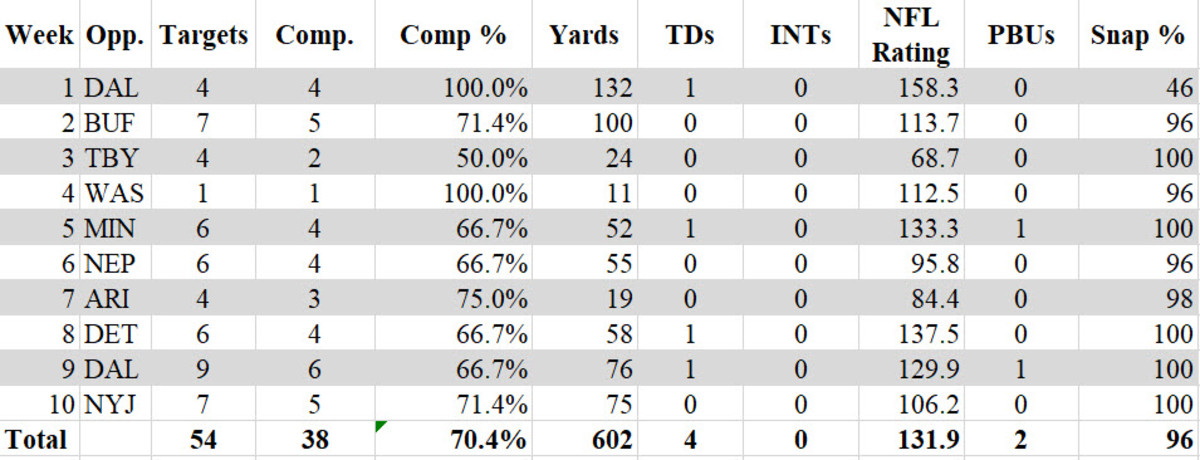Why DeAndre Baker is One of the Giants Most Improved Rookies from 2019

The New York Giants entered the 2019 offseason with plenty of holes to fill, but the secondary was arguably one of the most pressing areas of need.
After trading Eli Apple to the New Orleans Saints during the 2018 season, the Giants were projected to go into 2019 with Janoris Jenkins, and Sam Beal penciled in at cornerback.
The organization already knew what they had in Jenkins heading into the year. Sure, he could suffer from lapses in concentration from time to time, but “Jackrabbit” was still one of the better corners in the league, and his play bordered on elite when he was at the top of his game.
Beal, on the other hand, was still a mystery. Selected in the third round of the 2018 NFL supplemental draft, the Western Michigan product — who was considered by many scouts to be the best supplemental draft prospect since receiver Josh Gordon — didn’t see the field in his rookie year due to a preseason shoulder injury that put him on injured reserve.
He also continued his string of misfortune by starting the 2019 season on injured reserve. While he did make it back to the field, a late-season shoulder injury cost him the regular-season finale, raising concern about his durability moving forward.
Cash-strapped and unable to find suitable competition in free agency, the Giants turned to the 2019 NFL Draft for cornerback depth and maybe, just maybe, a future star that could be a long-term fixture in their secondary.
The Giants traded back into the first round to find that future star, Georgia’s DeAndre Baker. A consensus 2018 First-Team All-American, the rookie cornerback was one of the more highly-touted defensive prospects of the draft and had a track record to match the hype.
Baker was arguably the best cornerback in the country during his senior season, recording two interceptions, nine pass break-ups, and a 29.3 forced incompletion percentage while allowing a minuscule 40.2 passer rating against.
What’s most impressive, however, is that Baker allowed just one touchdown in his four-year career at Georgia (1,019 coverage snaps).
Clearly, the organization had high expectations for the former Georgia standout heading into the year — and it showed early on.
After playing on just 46 percent of Big Blue’s defensive snaps in Week 1, Baker was on the field for no less than 96 percent of the team’s defensive plays from Week 2 to Week 10. However, as many fans can attest to, the Giants weren’t exactly better off for it.
Growing pains are common for first-year players as they adjust to the professional level, but Baker looked completely lost on the field and was torched continuously in coverage.
The table below illustrates Baker’s performance on a per-game basis when targeted, as well as his per-game snap count percentage over the first ten weeks of the season.

It took a little longer than the fan base would have liked, but after weeks of underwhelming—and that’s being kind—play, the Giants finally realized that they might have put too much on the rookie’s shoulders. As a result, the coaching staff reduced Baker’s snap count after the team’s Week 11 bye.
Settling for a reduced role can be frustrating for a young player in their first season of professional football. Still, instead of packing it in for the remainder of the year, Baker responded to the coaching staff’s decision in the best way possible.
The 22-year-old defensive back looked like a completely different player when the Giants returned to action in Week 12, and he more than held his own for the remainder of the season.
Baker was one of the best corners in football down the stretch, per Pro Football Focus (PFF), and he saw a massive improvement in coverage.
The table below illustrates Baker’s performance on a per-game basis when targeted, as well as his overall snap count per contest over New York’s final six games of the season.

Baker’s post-bye passer rating allowed is admittedly a little high, but his 48.5 completion percentage allowed is on-par with some of the league’s elite corners.
If he were able to maintain his post-bye production throughout the entire season, the 22-year-old would have finished the year with a better completion percentage allowed than 2019 First-Team All-Pro selections Tre’Davious White (50.0), Stephon Gilmore (50.0) and Marcus Peters (55.6).
It’s a small sample size to work with and—outside of his lockdown performance against the Green Bay Packers—the competition he faced wasn’t exactly the best the league has to offer.
However, Baker’s improvement toward the end of the year could still be a glimpse of things to come. If he can build on his impressive second half during the offseason, the 22-year-old defensive back could be in for a breakout sophomore campaign in 2020.
